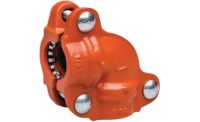The maintenance and refurbishment of piping systems in existing buildings presents many challenges from compatibility of the new system design to the risk of damaging the building.
No matter the reason for a system update, all instances require working with an existing application where compatibility of new and old products is not always guaranteed, but required.
Specifying the right pipe-joining method, such as grooved mechanical pipe joining, can help overcome several retrofit challenges, including sound and vibration attenuation, accommodating system expansion and contraction, reducing downtime, and overcoming risk of fire hazards with hot work.
Managing sound and vibration attenuation
Noise and vibration caused by mechanical equipment not only decreases the life of various system components because of vibration fatigue failure, but it’s also a key element in the comfort of the tenants.
In historical buildings, there are even more crucial factors that must be taken into account because insulation in old buildings is often rudimentary. As such, system noise can easily be heard throughout the property. In any application where undesired noise and vibration are being transferred through the piping system, owners and engineers who specify grooved mechanical pipe joining receive two vitally important benefits: higher productivity combined with less noise and vibration. This provides both economic and quality advantages.
Designers have traditionally specified elastomeric flexible arch connectors or flexible braided hoses to lessen the transfer of noise and vibration to be installed on the piping and connected to this equipment (see Figure 1). Elastomeric flexible arch connectors are not intended to handle the system pressure thrust loads, so control units such as restraining rods, plates and/or anchors are required.
While taking up valuable space, rubber bellows also are considered to be long-term maintenance items and require periodic inspection. Based on system and equipment operating conditions, rubber bellows may need to be replaced several times throughout the life of a system, which involves system downtime plus the cost of a new unit. Improper long-term maintenance may result in a catastrophic failure – causing not only serious safety risks, but also significant water damage and unscheduled system shutdown.
Installing three flexible grooved mechanical couplings on each side of a pump solves these problems, eliminating the need for costly vibration attenuation devices (see Figure 2). A resilient elastomeric gasket conforms to the internal cavity of the coupling housing and seals against the pipe. It is pressure-responsive and creates a permanent leak-tight seal. The gasket, having full circumferential contact with the coupling housing and both pipe ends, dampens the vibration and dissipates the mechanical energy.
Three flexible grooved couplings can be used not only with pumps, but also with chiller units, cooling towers and any equipment that generates noise and vibration. The use of additional grooved couplings — whether flexible or rigid — in the distribution piping will further reduce the transmission of vibration. By combining versatility with durability, this pipe-joining method provides a low-maintenance solution that saves space and delivers both practical and commercial benefits.
Accommodating system expansion and contraction
When integrating new applications into existing structures and confined spaces, mechanical pipe-joining systems also can be utilized to accommodate thermal expansion and contraction piping. Thermal transients may impose stress on a piping system as the pipe grows and contracts with temperature changes.
All materials, including pipe, experience dimensional changes as a result of varying temperatures and their coefficient of expansion. This often occurs as directional changes in the pipework causes bowing at the mid points of long, straight pipe runs, resulting in stress on the piping system and equipment.
Piping thermal movement considerations may vary between horizontal and vertical runs. Common considerations include how to accommodate the movement, clearance at changes in direction to allow for thermal growth, sufficient flexibility of branch lines and the support system allowing for or directing this movement. The design of riser piping must include how loading on the support structure changes as the piping thermally expands and contracts.
Inadequate accommodation of this movement can result in business risks caused by excess stress on the piping system (including increased incidence of ruptures and leaks) and increased stress on boilers, chillers, valves, and other equipment and components. Increased downtime and labor expenses can negatively impact the owners of the building by resulting in increased maintenance costs and potential shutdowns.
When accommodating thermal expansion and contraction, the grooved pipe-joining system conforms to industry practices. Simultaneously, it provides design flexibility, reduces stress on the piping system and provides a more compact, easy-to-inspect and productive method of installation over other pipe-joining methods.
Flexible grooved mechanical couplings allow for movement of the pipe because of the design of their components. The dimensions of the coupling key are narrower than the groove in the pipe, allowing room for the coupling key to move within the pipe groove. Additionally, the width of the coupling housing allows for pipe-end separation. This allows the grooved pipe joint to accommodate linear and angular movement. The mechanical coupling provides a self-restrained joint, and the unique pressure-responsive gasket design ensures positive sealing even under deflection and linear pipe movement.
Reducing downtime and overcoming risk of fire hazards
During retrofits, avoiding disruption to building occupants while minimizing cost overruns associated with night and weekend work can be a challenge. Grooved mechanical pipe-joining systems can address these issues because the flame-free technology is fast and easy to install and maintain, and eliminates the risk of fire. With fewer parts and ease of access to the system, grooved mechanical systems also speed up maintenance and eliminate the need for hot work permits and safety watch, all of which keeps system downtime and costs to a minimum (see Figure 3).
The speed and ease of installation, disassembly and reinstallation make the use of grooved systems the desired joining method to perform maintenance, such as access to strainers. To access a piping system joined with grooved components, a worker simply disassembles two couplings to drop out a pipe section. To complete the job, the grooved couplings are easily placed back on the pipe and the nuts tightened.
For the maintenance and refurbishment of piping systems in existing buildings, grooved mechancial systems provide a reliable alternative to welding and flanging. As a widely accepted pipe-joining method, grooved mechancial pipe-joining systems provide compatibility between exisiting systems and new system design.
These systems also can help to overcome many engineering challenges associated with sound and vibration, as well as system expansion and contraction, all while minimizing fire hazards and reducing downtime. Ultimately, the benefits associated with mechanical pipe joining result in an increased level of confidence by engineers and building owners alike.
Author bio: David Hudson is a senior product engineer for Victaulic Co., and is a practicing mechanical engineer with 33 years of experience. He can be reached at dhudson@victaulic.com




